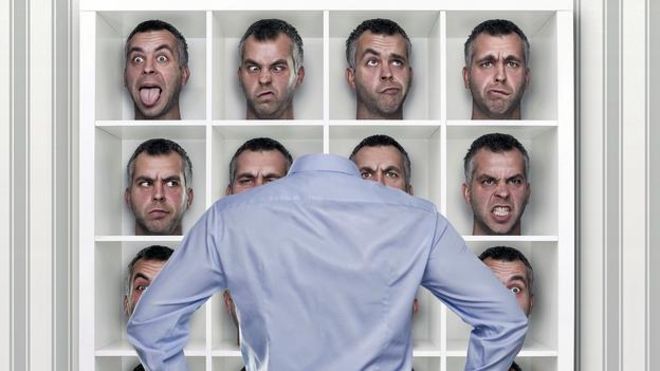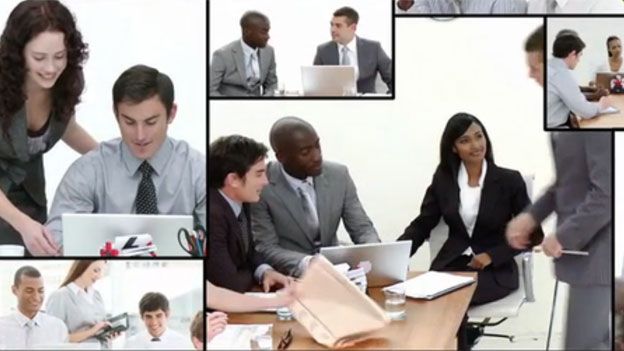求职面试 肢体语言能帮到你多少? - BBC伊丽莎白·伽隆(Elizabeth Garone)(2023年8月1日)

工作面试,除了着装肢体语言也很重要.(图片:Thinkstock)
塞缪尔·阿美嘉维萨(Samuel Amegavisa)感觉很紧张。这是他在加纳海岸角大学(University of Cape Coast)人体生物学专业就读的最后一年,所以是时候考虑工作面试的事情了。
“我的情况很简单,我之前从来没参加过面试,”23岁的阿美嘉维萨通过电子邮件告诉BBC Capital。他还提出了一个很基本的问题,一个我们多数人可能都没有认真思考过的问题:“关于面试开始前和进行过程中的坐姿,有没有什么建议?”
虽然所有人都知道面试着装的重要性,但却有很多人不知道肢体语言的重要性。你进门、握手或就坐时的动作,都透露出哪些隐含信息?
我们邀请3位肢体语言专家分享了他们的观点,帮助我们了解面试中应该使用和避免哪些肢体动作。
恰到好处
面试官与应聘者的第一次接触几乎都是从握手开始的。肢体语言专家、澳大利亚Paramount Training & Development 的培训师大卫·阿尔瑟玛(David Alssema)表示,第一印象往往能为接下来的面试定下基调,所以,这可能成为决定面试成功与否的最重要因素之一。
“有相似之处才能沟通,”阿尔瑟玛在电子邮件中说,因此建议跟面试官握手时尽量与之相似,“握手的力度和问候跟对方相匹配,表明你希望获得平等对待。握手时用力压过对方,则表明你希望主导此次会面。”
空间划分
无论我们来自哪种文化背景,潜意识里至少都会把周围的空间分成四块区域。由远及近分别是:公共区、社交区、个人区和亲密区。波士顿演讲教,《权力线索:领导团队、说服他人和个人影响最大化的微妙科学》(Power Cues: The Subtle Science of Leading Groups, Persuading Others, and Maximizing Your Personal Impact)一书的作者尼克·摩根(Nick Morgan)认为,面试过程中必须对此保持敏感。“人与人之间的重要事情都发生在个人区和亲密区。”他在电子邮件中写道,“由于亲密区在面试时属于禁区,所以,如果想加大面试官录取你的概率,你肯定希望进入个人区。”
主动

(视频截图)
尽管握手把我们带进了我们渴望的个人区 — 摩根认为这正是我们握手的原因 — 但面试中常见的座位安排往往会将我们赶出这个区域。“这让面试官很容易向我们传递信息,但我们却很难给其留下印象,”他说,“所以要寻找机会巧妙地进入面试官的个人区。”例如,你或许可以稍微挪一下椅子,与面试官坐在圆桌的同一侧。
等你坐下后,再考虑通过其他方法拉近距离,例如向前探身,但幅度不要太大。“尽量巧妙机智一些,别太快,也别太唐突,”摩根警告说。这的确值得一试。
“只要能拉近距离,便可增强信任和联系,哪怕是一点距离都行。”他说。
开放
摩根认为,必须保持肢体语言的“开放性”。你可能很紧张,也有可能握紧双手或把胳膊交叉于胸前。“这种姿势让人感觉既安全又舒服,但却会拉开你与对方的距离。”
另外,阿尔瑟玛指出,“交叉双臂表明你没有兴趣,而且会导致你无法探身。”
对视
“目光交流很重要,多了或少了都有可能表明不同的态度,”阿尔瑟玛说。怎样才是恰到好处?某些情况下或许很难说清,但阿尔瑟玛建议参照面试官与你进行目光交流的时间。如果是一组面试官,应当把眼神交流的时间合理地分配到每一个人。“回答问题时应当逐一与每个面试官展开目光交流。扫视表示厌烦,所以尽量不要这么做。”
很多人都有一种误解,认为良好的眼神交流就是一直盯着对方,但美国肢体语言专家、《就是这样:充分利用第一印象、肢体语言和领袖气质》(SNAP Making the Most of First Impressions, Body Language, and Charisma)一书的作者派蒂·伍德(Patti Wood)认为,这其实也是不对的。
“说话时不停地转移目光是很正常的,因为你的大脑在思考问题,”她在电子邮件中写道。只要记住一点:当面试官说话时,一定不要看向别处,“回答完毕时,记得进行目光交流,并倾听面试官的话语。目光交流表明你很认真,很主动。”
深呼吸
当一个人感觉紧张时,呼吸就会加快。这会对面试造成负面影响。
“当你的呼吸短促时,就不太容易完成清醒的思考,”伍德说,“这可能导致你无法快速而简洁地回答问题。”
相反,应当尝试腹式深呼吸。“这是让自己头脑清醒、精力充沛、信心满满的关键。”她说,“放慢呼吸速度,要在这一过程中使用你的横膈膜、腹部、胸腔和后腰。”当然,你肯定不想在真正面试时这么做。“但只要你感觉紧张,就应该试试看。面试时肯定会紧张,”她说。
(责编:郱书)
Can your body language win you the job? - By Elizabeth Garone
Samuel Amegavisa is getting nervous. In his last year of human biology studies at the University of Cape Coast in Ghana, it’s time to start thinking about job interviews.
“My situation is quite simple. I have never been interviewed before,” wrote 23-year-old Amegavisa in an email to BBC Capital. He had a basic question — one most of us probably don’t think much about. “Is there any recommended sitting position before and during your interview?”
While everyone knows it’s important to dress smartly for an interview, less obvious — and less known— is the importance of how you carry yourself. What hidden cues do you give when you walk through the doorway, shake hands or sit?
Three body language experts share their insights on what moves to make, and avoid, in an interview.
Happy medium
The first contact between an interviewer and interviewee is almost always a handshake. First impressions often determine how the rest of the interview goes, so this can be one of the most important elements of getting it right, according to David Alssema, a body language expert and training facilitator with Paramount Training & Development in Perth, Australia.
“Rapport is built by similarities,” so shake hands the way the interviewer does, recommended Alssema in an email. “Matching the strength or greeting shows you want to be an equal. Overpowering a handshake can signal a dominant attitude towards the meeting.”
Zones of space
No matter our culture, we all have and are at least subconsciously aware of four zones of space around us. They are (from farthest to closest): Public, social, personal and intimate. It’s important to be keenly attuned to these during an interview, according to Nick Morgan, Boston-based speech coach and author of Power Cues: The Subtle Science of Leading Groups, Persuading Others, and Maximizing Your Personal Impact. “The only significant things that happen between people happen in personal and intimate space,” he wrote in an email. “Since intimate space is off limits [in an interview], you want to get into the personal space of the interviewer,” if you want the person to be inclined to decide in your favour.
Make your move
While the handshake brings us into the personal space that we want — it’s why we do it, according to Morgan — typical seating arrangements in an interview tend to move us away. “That makes it easier for the interviewer to pass on us — but harder for us to make an impression,” he said. “So look for ways to tactfully move into the personal space of the interviewer.” For example, you might move your chair slightly or sit on the same side of a round table.
Once you’re seated, consider other ways to close the distance. Lean forward, for example, just not too much. “Try to do this tactfully and subtly, not rapidly or awkwardly,” cautioned Morgan. It’s worth the effort.
“We increase trust and connection with people when we close the distance between us, even by small amounts,” he said.
Please click the arrow above to see how to improve confidence with certain postures.
Open for business
It’s very important to keep your body language “open,” according to Morgan. You’re likely to be nervous and you might find yourself unconsciously clutching your hands in front of you or folding your arms. “These feel safe and comfortable, but also distancing and disconnecting for the other party,” he said. In addition, “[folding your arms] shows that you are disinterested, and it also prevents you from leaning,” said Alssema.
The eyes have it
“Eye contact is important, and any less or any more than a reasonable amount may indicate other attitudes,” said Alssema. What’s just right? That might be hard to tell in some situations, but Alssema suggests mirroring the amount of time the interviewer gives you eye contact. If there is a panel of interviewers, it’s important to provide the right mix of time for each person. “Respond to each person individually with eye contact when answering questions,” he said. “Glancing around is a signal for boredom, so avoid it if possible.”
People often make the mistake of equating good eye contact with never looking away — but this would be a mistake, too, according to Atlanta, Georgia-based Patti Wood, a body language expert and author of SNAP Making the Most of First Impressions, Body Language, and Charisma.
“It is normal to look away from time to time as you speak, because you’re accessing information in your brain,” she wrote in an email. Just don’t let yourself drift off when the interviewer is speaking. “After giving an answer, remember to make eye contact and listen to the interviewer. Eye contact sends the message that you are serious and engaged,” Wood said.
Don’t forget to breathe — deeply
The moment people get nervous, the more quickly they start breathing. That can wreak havoc in an interview.
“When you take quick shallow breaths, you reduce your ability to think clearly,” said Wood. “This may keep you from answering questions quickly and succinctly.”
Instead, try to breathe deeply from low down in your belly. “[It is] one key to feeling clearheaded, energised, and confident,” she said. “Practice breathing more slowly, using your diaphragm, belly, rib cage and lower back in the process.” Of course, this isn’t something you’ll want to do in your actual interview. “But try it whenever you get anxious and certainly before your interview,” she said.